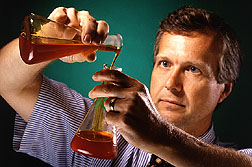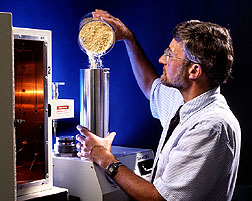Corn Fiber Yields Oil and Gum Products
|
|
From the hull of a kernel of corn, Agricultural Research Service scientists, with help from the University of Massachusetts, have discovered and patented a new corn fiber oil that may lower serum cholesterol levels. A second new product a valuable white corn fiber gum was also discovered in the fibrous hull and is being patented by ARS.
This research has captured the interest and backing of two major companies, Monsanto and the National Starch and Chemical Company. It could also lower the cost of producing other corn-derived products, like fuel ethanol.
"These companies have signed agreements to further develop the technology," reports Kevin B. Hicks. "Eventually, this should create jobs, provide new uses for agricultural byproducts, increase income for processors and growers, and develop healthy new food products for consumers.
Hicks, along with fellow chemists Robert A. Moreau and Robert A. Norton, discovered the new corn oil. He heads the Plant Science and Technology Research Unit of ARS' Eastern Regional Research Center (ERRC) in Wyndmoor, Pennsylvania, where Moreau leads the corn fiber research project. Norton is based at ARS' National Center for Agricultural Utilization Research in Peoria, Illinois.
Preliminary studies with hamsters by collaborator Robert Nicolosi, a nutritional biochemist who directs the University of Massachusetts Center for Cardiovascular Disease Research, indicate that the new corn fiber oil significantly lowers total serum cholesterol and LDL cholesterol, which is the kind that clogs the arteries. The patent application for "AmaizingOil," made jointly with the University of Massachusetts, covers the process for extracting the oil from the fiber, use of the oil to produce cholesterol-lowering products, and individual components of the oil.
|
|
"We knew that the corn milling industry produces huge amounts of corn fiber residue that is made into livestock feed and sold for only about 5 cents a pound," says Hicks. "We wanted to turn this potential waste disposal problem into an opportunity, which we did by processing cheap fiber into valuable new products for which there would be a strong market."
Corn fiber is a low-value byproduct of wet milling, the industrial process that produces starch, sweeteners, fuel grade ethanol, and other products from corn. The corn processing industry produces about 4 million tons of corn fiber each year, which could yield about 80,000 tons of corn fiber oil. This fiber is now sold as corn gluten feed, a low-cost ingredient in cattle rations.
Just how did Robert Moreau's team discover corn fiber oil?
"I knew that Bob Norton in the ARS Peoria lab had done some work with the cholesterol-lowering potential of compounds in corn bran, which is similar to corn fiber except that it's produced by dry milling, instead of wet," Moreau explains. "So I took a closer look at exactly what happens to a kernel of corn during wet milling."
In wet milling, the first step is to steep, or soak, the kernels in water to soften and swell them. After steeping with sulfites for 2 days at 140oF, the soft kernels break into four products the germ, starch, a high-protein product, and the hull, or fiber.
"We extracted the new oil from the outer hull, or seed coat. Conventional corn oil comes from the germ," Moreau says.
Moreau collaborated with Nicolosi on preliminary feeding studies. When Nicolosi's results showed that the corn fiber oil significantly lowered total serum cholesterol in hamsters, the team was off and running.
Under terms of the ARS agreement with the University of Massachusetts, university cooperators have the right to grant licenses for the process. On July 23, 1997, they issued an exclusive license to Monsanto of St. Louis, Missouri, to further develop the corn fiber oil technology.
|
|
Monsanto will provide several hundred thousand dollars in upfront payments, royalties on future sales of corn fiber oil products, and potentially several million dollars in payments as various milestones are reached. Monsanto will also supply considerable funding for ARS corn fiber research.
"We plan to use this oil in a variety of food applications, hoping it will lower cholesterol levels. We're excited about working with ARS and the University of Massachusetts over the next couple of years," says Charles Hough. He is director of business development for Monsanto. "ARS' idea of taking a low-value product and turning it into a healthy food is consistent with Monsanto's mission of helping people live longer, healthier lives," says Hough. "This is an area we'd like to focus on in the future."
After Moreau had extracted the corn fiber oil, he gave the defatted fiber to colleague Landis W. Doner, also a chemist and member of the corn fiber team at ERRC.
The defatted fiber is about 50 percent hemicellulose, a polysaccharide that is a carbohydrate more complex than sugar. Doner hit pay dirt when he discovered a way, using alkaline hydrogen peroxide, to separate and extract the hemicellulose from the corn fiber.
"For about 50 years, researchers have been searching for ways to produce a viable gum from byproducts of the corn processing industry. Several processes have even been patented, but none have been commercialized because all the materials were tan to brown in color," Doner explains. "Food processors and industrial users want corn fiber gum with very little color."
Doner's corn fiber gum is extracted as a smooth, white powder, bland in flavor and aroma. When mixed with water, it looks and acts like a gum. The gum could be used in foods as an emulsifier, a soluble dietary fiber, or a thickener. Industrial applications could include adhesives and water-based paint thickeners.
While corn fiber yields 2 percent oil, Doner says it yields 40 percent gum.
Doner and Hicks have applied for a patent for "Zeagen" and recently signed a cooperative research and development agreement with the National Starch and Chemical Company (NSCC) of Bridgewater, New Jersey.
"We're anxious to get started on scaling up this process to find a wide range of food and nonfood uses," says Roger Jeffcoat, NSCC's divisional vice president for natural polymer research and biotechnology.
Future Possibilities
Believe it or not, there's still more to this research project.
"Currently, the United States has an enormous trade deficit, about 40 percent of which is due to our importing petroleum," says Hicks. "Valuable coproducts from this corn fiber research will offset the cost of making all corn-derived products, including fuel ethanol. If we can replace imported petroleum with our homegrown fuel ethanol, we could have an impact on the national economy.
[For more on ethanol production, see "Improving Ethanol Yield From Corn," Agricultural Research, October 1996, pp. 8-11.]
Currently, the cost of fuel ethanol makes it very difficult to compete with gasoline. But valuable new products will hopefully lower net costs for ethanol production.
"Coproducts now decrease the cost of ethanol by about 60 cents a gallon," says Hicks, and our new technologies should lower this even more. Our goal, like that of our partners in these ventures, is to help growers, industry, and consumers." — By Doris Stanley
Robert A. Moreau, is in the USDA-ARS Crop Conversion Science and Engineering Research Unit, Eastern Regional Research Center, 600 East Mermaid Lane, Wyndmoor, PA 19038-8551; phone (215) 233-6428
USDA-ARS National Center for Agricultural Utilization Research, 1815 N. University St., Peoria, IL 61604









